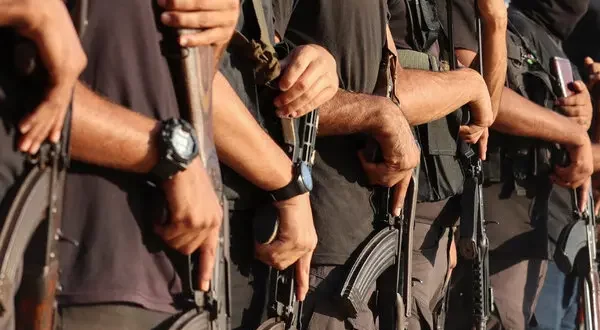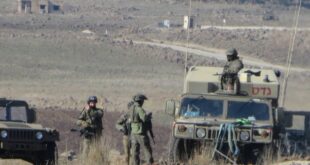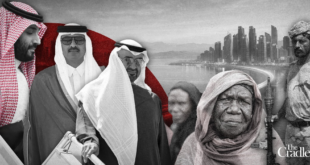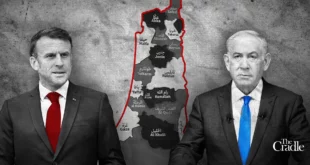A video this week captured Hamas fighters in Gaza executing Palestinian rivals as the militant group tries to assert that it is still the dominant force in the territory after two years of war with Israel.
The public execution was captured on video.
Masked gunmen, some wearing green headbands associated with the Palestinian militant group Hamas, lined up eight captives in the middle of a crowded street in Gaza City on Monday. They forced the men to bend over, leveled their rifles at them, and opened fire, leaving their bodies in the dirt.
A Hamas internal security official confirmed that the video, which The New York Times geolocated to Gaza City, showed Hamas fighters executing Palestinian rivals. He spoke on condition of anonymity because he was not authorized to talk to journalists.
The execution took place just days after a cease-fire with Israel began on Friday and Israeli forces pulled back from parts of Gaza. Analysts say that Hamas appears to be trying to assert that it is still the dominant force in the territory, no matter how weakened it is after two years of war with Israel.
Hamas lost many of its top commanders and thousands of fighters in the conflict, and some Gaza residents launched rare protests against the group’s iron-fisted rule earlier this year.
Israel has acknowledged that it also sought to undermine Hamas’s control by backing rival Palestinian clans in Gaza, with mixed results.
“Hamas is sending a message: ‘We are here. We are the sole authority in Gaza,’” said Tamer Qarmout, a Palestinian political analyst and academic from Gaza, who is based in Qatar.
Since Monday, at least 10 members of Hamas’s security forces and at least 20 members of rival Palestinian groups have been killed in the internecine fighting, according to a Gaza health official and the Hamas internal security official.
It was not clear whether the eight men who were executed in the video were counted in those tolls. Some of them were members of the Doghmosh family, which has a long-running rivalry with Hamas, Nizar Doghmosh, a family leader, told The Times on Wednesday.
The outbreak of internal violence in Gaza, which has been limited to a few incidents so far, could further complicate President Trump’s vision for a postwar Gaza. His plan to end the war requires Hamas to lay down its weapons, allow an international force to stabilize the territory, and effectively end its two-decade control — demands the group has rejected so far.
After a visit to Israel on Monday coinciding with Hamas’s release of the remaining hostages in Gaza, Mr. Trump was asked by a reporter about the possibility of the group reasserting itself as a police force in Gaza and shooting rivals. Mr. Trump suggested the United States was not opposed, at least for now.
“They’ve been open about it, and we gave them approval for a period of time,” he said.
On Tuesday, Mr. Trump addressed the issue again, saying Hamas had “taken out a couple of gangs that were very bad,” and adding: “That didn’t bother me very much, to be honest.”
The U.S. military’s Central Command — which oversees Middle East operations — later issued a statement telling Hamas to stop shooting at Palestinian civilians in Gaza, adding that the United States had conveyed concerns over the violence to international mediators.
During the war, uniformed Hamas fighters were rarely seen on the streets of Gaza. They avoided moving in the open as much as possible so they would not be targeted by Israeli airstrikes.
Image
Hamas militants in Gaza during a hostage transfer in February.Credit…Saher Alghorra for The New York Times
Palestinian witnesses in Gaza say groups of masked, rifle-toting Hamas security forces are appearing again now, including when Hamas handed over the remaining hostages to the Red Cross on Monday.
Some of the Hamas activity does appear to entail restoring public order in Gaza’s daily life. In the central city of Deir al-Balah, for example, armed men have been spotted in the streets directing traffic this week, which they had hardly done throughout the war.
Hamas officials publicly acknowledge that they are also launching operations against people they deem to be lawbreakers or collaborators with Israel.
Two Hamas internal security officials said the killings shown in the video were in retaliation for the Doghmosh family’s killing of several Hamas militants during the war.
The clashes that led to the killings shown in the video began on Sunday, Mr. Doghmosh said, after Hamas had sought to apprehend members of the family it accused of being collaborators with Israel. He denied that the family as a whole was working with Israel.
Later that evening, Hamas fighters and armed members of the Doghmosh family fought a pitched gun battle in Gaza City, according to two Gaza health officials, two Hamas internal security officials and Palestinian residents.
One of those killed in the clashes was Naim Naim, whose father, Basem Naim, is a senior Hamas leader, according to two family members and one of the Gaza health officials.
After the clashes, armed Hamas fighters burst into nearby houses, checking identity cards to see who belonged to the Doghmosh family, said a Palestinian witness who asked not to be named for fear of retribution. He said his family spent hours huddled in the center of their home amid a hail of gunfire and explosions outside.
Then Hamas fighters showed up and ordered them to flee, he recounted.
At least 24 bodies arrived at Al-Shifa hospital in Gaza City from the Hamas-Doghmosh clashes on Sunday night, said Mohammad Abu Salmiya, the medical facility’s director. He said he did not know how many were from each side.
On Monday, the day after the gun battle in Gaza City, the Hamas gunmen were filmed shooting the masked and blindfolded men in the middle of neighborhood where the clashes took place, surrounded by a large crowd of bystanders.
Hamas’s interior ministry has warned rival groups that it will come after any “criminal gangs” that threaten “civil peace.” It called for members of those groups who were not involved in killings to hand themselves over in exchange for amnesty and warned that anyone who did not would face consequences.
Mahmoud Mardawi, a Hamas official, vowed on social media on Tuesday that the group would not allow “chaos to spread in beloved Gaza nor criminals to escape punishment.”
Military analysts say a major target for this Hamas crackdown will likely be the string of small Palestinian militias that have sprung up in Gaza over the past several months, though it is not clear whether Hamas has already moved against them in force. None have mounted a serious challenge to Hamas yet, the analysts said.
Some of these smaller militias say they have worked in coordination with Israel.
Prime Minister Benjamin Netanyahu of Israel confirmed in June that Israel was “using clans in Gaza” who were fighting Hamas on its behalf. Israeli officials later confirmed helping to arm one operated by Yasser Abu Shabab in eastern Rafah.
Mr. Abu Shabab was notorious for ransacking humanitarian aid from U.N. convoys earlier in the war, according to aid officials. Later, he set up a militia in an Israeli-controlled zone inside Gaza, saying this zone would be peaceful and free of Hamas. His militia uploaded videos showing makeshift classrooms and quiet tents in an effort to attract displaced Gazans to join.
“This adventure was only ever going to end one way,” said Michael Milshtein, a former senior Israeli intelligence officer. “We armed and supported these militias, and now Hamas is coming for its revenge.”
If Hamas attacks any of the clans affiliated with Israel, it would pose a “heavy dilemma” for the Israeli authorities, who would have to decide whether to defend them — thus breaking the cease-fire — or allow them to be killed or arrested, Mr. Milshtein said.
For now, at least some militia members say they have no plans to surrender to Hamas.
“We are preparing to defend ourselves by any means necessary should Hamas attack,” said Mohammad al-Mansi, 21, whose father leads a small armed group opposed to Hamas in northern Gaza.
“We won’t turn ourselves in. We would rather die.”
 Eurasia Press & News
Eurasia Press & News



